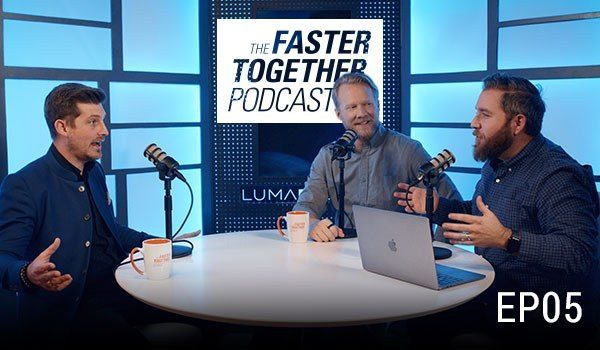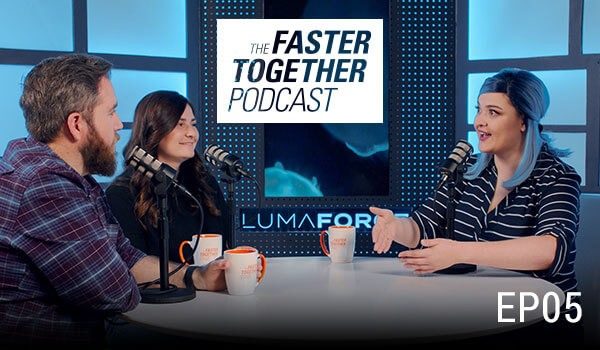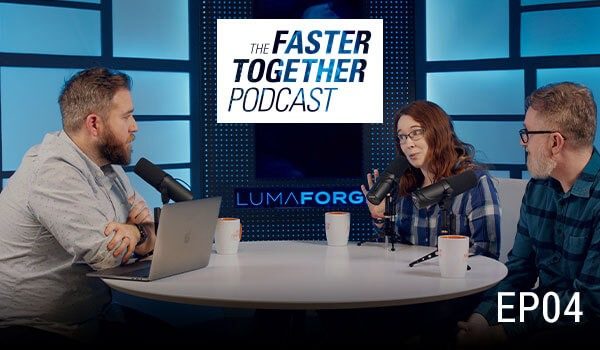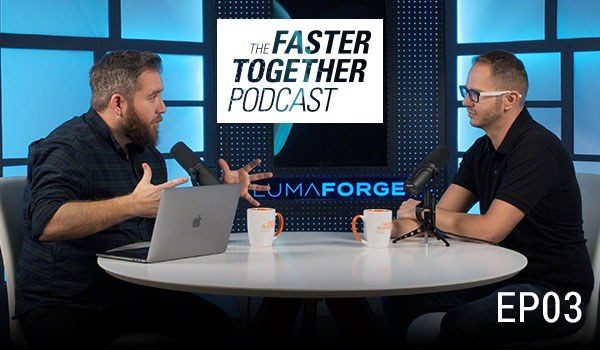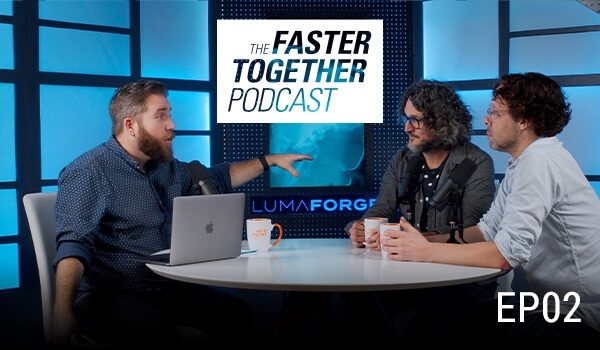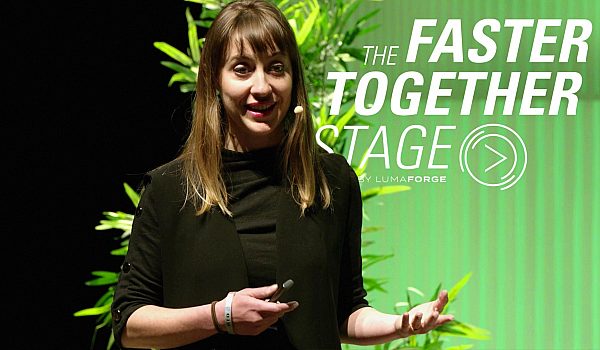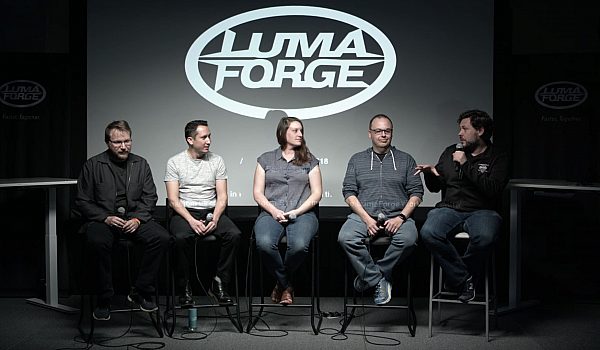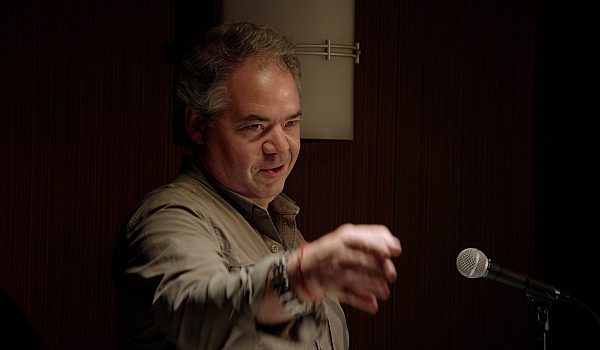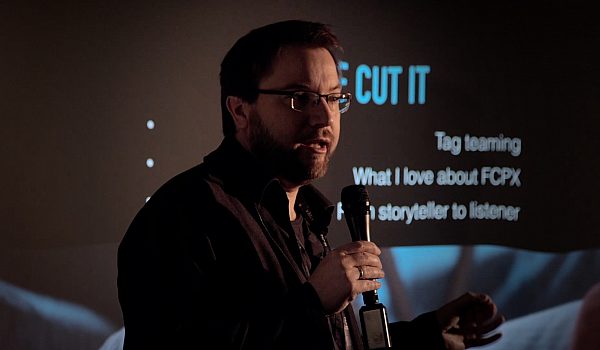Michael Cioni gives the State of the Digital Union at the Faster Together Stage during NAB Show 2019. Learn his Top 4 Reasons NOT to come to NAB and what the history of the Luddites can teach us about technological skepticism.
Good evening everyone! Thanks for having us here. You know, I've always kind of struggled with this concept of like how much can we control the future? We all really really want to control the future. And over time I've kind of realized that controlling the future is pretty much impossible, you're not going to be able to do that very easily, but maybe the keyword to this is activating the future, and activating your future and figuring out where you fit in it, and that may have a lot more to do with being able to control and put yourself in the postilions that you need in order to succeed.
That's kind of the principals that I've applied, and I want to talk, not just, you know, esoterically or sort of melodramatically about that concept, I want to unpack the few new concepts to arm each other with the tools that we can do to take advantage of this. My name is Michael Cioni, and I'm the Senior Vice President of Innovation at Panavision, I was the founder Light Iron, and I'm also the product director of the Millennium DXL camera. You know, this is the, really important thing for us because this is the most fully featured camera on the professional market. And when we mean fully featured, we really mean that, but you know, I was thinking, how did we get to this point? How did this Light Iron start it? How do companies like Frame.io and LumaForge move forward and how did cameras like the DXL come into existence?
You know what I realized, it must have nothing to do with any NAB, because every time I come to NAB, somebody doesn't come says I don't need to go to NAB, so certainly it can't be because of NAB, that any of this stuff happens. In fact, I hate NAB so much and I have so much time, I decided to make a list of reasons not to come to NAB, so that you can be, this can help all the people that didn't come so everybody watching that didn't come, I'mma even help you make reasons not to come to this place, you know, I don't need this new tech, I don't have time to sort all this stuff out, I don't understand it or especially the situation of uh, you know, it's just way to crowded, so this is obviously great reasons not to come to NAB, so congratulations for not showing up, because uh obviously we don't need to be here. You know, so that's obviously not a really good plan of attack, and it makes me think of something, there's this guy named Ned Ludd. Maybe you've heard of Ned Ludd.
You know, the interesting thing about this story of Ned Ludd and the movement that become part of Luddite is something we put into this because the original story that we've been told is that this Luddite is this anti-technology person. So here we are, in the early 19th century, right as the Industrial Revolution is taking place in Northern England. And there's this group of people that find out that this loom is being made, so you know like, rugs like this and carpets, and blankets are getting made through this loom, and as this is happening the Luddites come in because they're anti-modernization, and they're anti-technology, and they say we need to destroy this because this is gonna ruin everything about this. And you probably heard this. But it turns out, that's not true. It turns out that the Luddites were not actually standing up to try to kill this stuff, a Luddite was actually, Ned Ludd didn't even exist, this wasn't even a real person, it was a movement, it was sort of like their version of, you know, Batman, this is like the everyone hero. But it turns out what they were truly concerned about is the exploitation of the work.
They believed that manufacturers and owners of businesses could take advantage of new technology to lower the quality standards of what was being created, and they could take advantage of talented people, and the Luddites simply wanted to protect the quality of the work to make sure that when the technology came online, the quality of the work didn't suffer. Now that's a different story. It's also pretty interesting, and I think it's a good thing. I think that technological skepticism is a good way to make sure that we have some harmonious balance between the quality of the work and the wage that we earn. And the execution of that through the Luddite story is to make sure that there is balance. So I actually believe when we look at this, you know, world of NAB here we see all these different things. And you see all these things, these are just a few things that I've been looking at NAB that I think are really interesting developments in the market, and there's so many of these things going on, you can kind of see like wow, there is a lot out there, and there's gonna be a lot of technology change there. But at the same time, it kind of gets me a little interested to kind of figure out, well how is this going to affect me? And I think that technology skepticism, the Luddite inside of us might not always be a bad thing.
Democratization, unfamiliarity, the overload of this, and job security is certainly at risk with some of these technologies, and we need to be aware of that. I kind of broke it down a little bit more, I think these are true reasons to be skeptical of technologies so that you don't just get honed in by the marketing, and the flashy lights, and the peer pressure of some emerging technologies, and start realizing that, I need to go this way, I don't understand, I gotta go this way, I gotta invest in this, I gotta buy this, I gotta do this, I gotta sell this. Because I think when it comes down to where I want to go, technology skeptics are welcome. And I think that's an important foundation to understand and figure out how we're gonna go forward, and make sure that we're making the right decisions so that when we get in arguments, our objective is to learn when we argue instead of to win something. Because you don't make any forward progress if we are trying to win a discussion, at least that's kind of what I find. So, this is kind of makes me interested in this, because now I look back at my list and it's like, wow I don't really need new technology, I gotta cross that off the list because now I realize that the first reason to come to NAB is to get exposure to the new technology, not to fight it, and to be able to be skeptical for the right reasons. So I'm changing some of my language, and I learned in sort of researching this that the term Luddite is that, it's not exactly what we thought it was, and we got to start there. But that second question is kind of a really good reason not to NAB, I don't really have time to sort through all this new technology.
And when I think about all the new technology, you know one of the problems here is that we have to figure out, you know, where is this new technology gonna take us, because there have been a lot of trends and some people get invested in the new technology, and when they get invested in those trends, they don't always pan out. You know, you might remember, like back in 2011, remember like uh when you had to have all the D's? We were there, right? We had to go through all that together and then we, of course we might remember Drone-a-thon, you might have been there for Drone-a-thon, and uh that was pretty interesting, where you basically went through the showfloor and you couldn't hear anything because there was a helicopter everywhere you were going, and that was kind of interesting, I don't know where those guys went but, uh, and then of course you probably looked in the last year or two years and now it's basically VR is basically virtually everywhere. And all of these things create that peer pressure on you, and they create this, this need to belong and this momentum, and you're kind of wondering, how much of this is going to impact me? And I think that's really an interesting point to think about because we have to identify the difference between a trend and a fad, and that is not easy to do. Because everything might look like a trend, even when it's actually only going to ever be a fad at best.
So how do we figure that out? Well, if we look at this list of things and we've seen all of these elements, now look at this with a different perspective, not with the skepticism, but the identification of whether or not some of these are trends, and whether or not some of these are fads. And you know, the problem with that is this can really really scary because this list will get bigger, and bigger, and bigger, I'm just touching the surface with this stuff. And it kind of starts to get me a little bit fatigued, I start to get a little concerned about my decision making process, and when I have too many choices my decision making process gets really hard to kind of get clear because I start to get foggy and it's like. You know, a really good example of this situation, it's like where am I always having trouble making decisions because I have too many and? I realized it happens a lot at The Cheesecake Factory. I mean, if you're ever like gone to The Cheesecake Factory, I mean, these guys have a menu, I mean, look I have it here, like this thing, have you ever gone through a Cheesecake Factory menu? I mean this, it's 21 pages for goodness sakes! It has a spiral binder because this thing just goes on for days, you know, this is, this is like, this is crazy because it's so hard to make good decisions when you have so many choices you start to get something that's called decision fatigue. And this is really a principle in which when the brain is given so many choices, it really is hard for you to make a decision. It's a lot easier when the menu is smaller, it's a lot easier when the NAB technology menu has less information and less people in it, right? And so it's like decision fatigue can actually be a contributor to making bad decisions, which can translate into bad investments, with your time, with your technology, with your businesses, all that stuff can be affected by this.
And so we need to basically figure out, well how do we determine trend? How do we figure out the difference between a trend and a fad? How do we examine that and what's a practical way we can do that? Well, I though of something we can really look at because I want to help identify together what could be used for this. You know, there's a really cool thing that we can use to determine a trend, it's cassette tapes. You know, cassette tapes are interesting because if we're going to use them, and I'm serious here because cassette tapes are coming back. And you know, you could go to, um you know a, certain places and they're selling VHS tapes again and all these things are starting to come back, and it's like, well that's got to be a fad, right? You know, when you take the cassette tape, you look down and then you've also seen the vinyl come back, of course we've seen everything with vinyl, right? And you notice that a lot of these companies that build a ton of uh products over the years, they're coming back with revitalizing the logos from the past, and that's certainly part of this trend as well. We've got people that are actually learning to crochet and to knit and there's classes and all these things are becoming normal, and it's like blowing your mind, like in this crazy digital age as we enter 2020, people are actually taking crocheting lessons, which seems crazy. And of course, you know like, this guy is all over the place! And he's been passed away long before anyone who turned him into a shirt knew he was alive.
And what Bob Ross has done is actually brought something part of this trend, it's not about the retro side of him, it's about his interaction, and of course, you're not cool if you're not shooting film everybody knows that. So all of these things are part of this trend, but you know what these are all the fads that work together to create a trend. And this is a new thing that I think is super important for everyone in this room and everybody watching, and it's a concept that myself and my partners, Collin and Tommy, came up with which we call tactile attraction. Essentially this something we've sort of determined, we've sort of identified, we're looking at the market as it's changing and we realize that tactile attraction is this cerebral connection that people have that is in all about the physical world, interaction with the physical world. Since 2007 with the invention of glass-faced technologies that deliver us everything everywhere on the go, we have actually been attracted to that and as time has gone on, we're missing the tactile nature of interacting with the physical world. Nobody knew this was coming, nobody did anything wrong, nobody made a wrong turn, we didn't know cerebrally what was going to be missing from us until it went away for a long time. And on vacation from tactile things, for now 10, 15 years, all of a sudden we're like, you know what I miss that physical interaction. And so, what I think is gonna happen here, is an opportunity because society's telling us right now that the next trends are gonna be born out of physical interaction. It's all over the place, and those are the things that I showed you in the last section there because this is all going to happen because we're getting really really interested in that. So if we're gonna anticipate the trend's roadmap, well this is something to be looking out for.
Skeuomorphism is the interaction in which electronic displays emulate the physical world, and you're gonna see more of that happen and in a new way, and when you start looking at the way things work, you know, you're gonna go to an airport and instead of seeing a digital display you're gonna see a digital display that's going to have an animation of the flipping tiles, and it's gonna look like that cause we're gonna feel good about seeing a Skeuomorphism representation of a clock, a clock is going to look more like a clock and less like a series of numbers. Another example is showrooms, people want to physically interact with things not just in a rental community or own them, they want to go to showrooms. Zeiss is a good example of a company that just opened up a showroom, Zeiss has been around for a century, and now they have, for longer than that I suppose, and they've got a showroom now, and they're starting to build these cause they want to see people interacting with the machines, and the technology, and the lenses, and the optics, and we're seeing showrooms go up everywhere and it's a new form of tactile attraction. And then of course, I think there's going to be, it's going to affect content cause everything that we do eventually affects our content. And while we've always seen period pieces, we're gonna continue to see more and more period pieces because it's part of this, a tactile attraction to this world, and so it's not like in the future we're gonna see more movies only about the future or the present, we're seeing period pieces about the 1990s. Right, there's a huge surge of movies that take place in the 1980s and 90s, and this is tied to this. And of course if you make a film or a TV show, eh Ian Vertovec, one of the colorists at Light Iron, I asked him a couple of weeks ago, Ian about what percentage of films do you add grain to? And he said, let me think, oh 100%. 100% of the projects we work on, which is about 150 features a year and 500 episodes of TV, Ian's adding 100%, uh grain to 100% of these projects because it's part of the, it's removing the synthetic side of this stuff and it's adding in a tactile side to it, and that's having an emotional response with people. This is an example of a lens we make at Panavision called an H-Series lens.
Notice that this lens, shot on, in 8k, is totally broken down, this lens is creating an image that doesn't scream digital at all, and it doesn't scream clarity at all, this is all about a texture that is being attracted by our society, people are going towards this, and the reason this is really important is because more than half of the people may be watching this scale down on a mobile device, and in order for an image, think about this, in order for an image to behave on a mobile device, it has to be broken down so much more at the source so that when it supersamples and scales down to that mobile device you can still see the characteristics that were in the beginning. Because normally when you take something and scale it down, it's going to not exhibit all of the same characteristics because some of those textures go away, so you have to almost overcompensate for it at the source in order for that behavior to be maintained throughout a pipeline and an image chain of custody that changes from photography down to watching it in the subway.
These are things we need to be concerned about, and our society is telling us this through these little clues if we're willing to look at them and learn about them. So what can you do to decide if you want to invest in this stuff? Well if you want to invest in this stuff, I think there's three places you might put yourself in. None of these are incorrect places, all of these are correct depending on the investments you're looking for, and whether you're a conservative or a skeptic, or you're going to be heavily invested in emerging technologies, this is where you might find, is this something I can invest in today, and then I might be taking a risk, or is this something I want to be conservative on? If you're working in the gaming world, the things you need to be conservative or invested in are different than if you're in the VR world, which are different than if you're in the photography world.
This is where you need to find yourself, and you can also take it a step further, where is the risk? It's pretty low if you don't over-invest in something and you wait to be sure. But the longterm risk is low, but the payout's gonna be lower too. If you're really invested in something, a short term risk is going to be very high, but the longterm risk could continue to be very very high, but the payout would be a lot bigger if you bet big and you are able to predict in a, a trend out of a fad. This is what I spend a lot of my time doing. I try to find different clues that tell me what is gonna be a fad and eventually turn into a trend? That's what I meant by showing the Pepsi logo or a Bob Ross t-shirt, all of those are actually fads that are telling us in a cumulative effect what the trend is going to be, and that makes a trend a little bit more likely to bet on, so it's a safer bet for you to invest in. So there's our second section and that's, you know, I don't have time to sort through new tech, but really it's about personalizing the emerging technologies. You know it's like so important to understand that it is possible to personalize technology, and you gotta take that, all that information at NAB, and you gotta synthesize that and apply it to yourself. Don't worry about person next to you, don't worry about the company down the hall, think about its application to you, that's what I try to do, and then I listen and I will argue with other people but with my intentions to learn instead of to win.
Now, the last thing I wanna really touch about is this concept which is really important, how much content is being made and how much, too much content is being made? Well there is a company, there is a group of people that I think could teach us a lot about how much content is being made. It's these guys, DAHFANG. This is a content explosion. And this content explosion through DAHFANG is really really powerful because this group here has so much going on, um and this is the concern though I hear from a lot of people and it's a really interesting concern, and that's concern about quantity over quality. And here's the problem, the question here is that if we increase the quantity of something, it must mean the quality has to go down. That's a fair argument, I think there's definitely some, some theory inside of that. So let's unpack that. So I think this actually the wrong question. I think we're attacking this as a binary response, where we're saying it's either quality or quantity, and I wanna challenge that, and here's how I would challenge that. If we're gonna learn something about the quantity of something, here's how we can learn. There's a group that can teach us a lot about this. Flat Earthers. They could teach us a lot about this concept because, see the thing is the Flat Earthers are not about, it's not about whether or not that they're correct or they're incorrect, that's not the point.
The point is that Flat Earthers want to belong to something, don't think of them as wrong, think of them as different, because everybody want to belong to a community, and our community just got bigger with over the top exhibition and distribution. Every single community wants new content, and all these communities generally follow the same trends. So instead of looking at Flat Earthers as this wrong group, understand that the content explosion is so big that you now have an audience of people that think the world is flat! You didn't have that audience before and now you can monetize that and work towards it and identify how big this is. You know, you could like figure out, you know they might like shows about pancakes for example, that might be pretty good, you know? Or, you know, how to fix a flat tire, they would be really interested in how to do that. You know, and all of them I imagine want to know how to get a flattop haircut really really cleanly. So these are all opportunities if you know how to look for the sources, even if they're really obscure. That's what these opportunities give us in going forward. But then what about the idea of quantity going down and the quality going up? Can we do that? Well, that answer is a little bit different and it's a huge opportunity.
Read chapter two of the book Outliers. Chapter two in Outliers is all about what's called the 10,000 hour rule. And Malcolm Gladwell didn't come up with this theory but he, uh examines it and unpacks it really really well. Now I admit, this is a super saturated market. But that's a good thing. All these OTT platforms that DAHFANG is putting out there it's new! But that's an opportunity. Strategies ar becoming very very fragmented and they're kind of all over the place, but that's an opportunity, and some, um, components are coming out so the strategies are, you know, really kind of asking about compromises and that is still and opportunity. But here's the opportunity for you, as the quantity goes up, you have an opportunity to be the quality, to maintain it there. That's what the Luddites actually meant to do in the first place. It's your 10,000 hours that you put in to become a professional that are gonna continue to make sure that as the saturation of the market goes up, the quality of the market remains the same or goes up as well. I don't believe for one second that it is not possible to improve the quality of our content even though the scale of it must go up as well. I think it's a defeatist attitude to say that quantity must impact quality. I don't want that to be in my businesses and the people that I work with, and I think we have the answers to that. So, that section is really, there's not much, you know, there's too much content being made, but really that's the opportunity because expanded market means there's expanded opportunity. And then for the last people that didn't show up, I want to talk to the people that didn't come to NAB because it's too crowded. This is about community.
And when we're talking about community, this is the room of people that know how to activate the future, because you're participating in the community. There are millionaires sitting in this room that are not yet millionaires. For sure, it's true, it's true. And you don't know that the person sitting next to you might need the encouragement from you to help them make the right decision on taking that next step forward, that's what community actually does. None of the things from my businesses, or the partners I have, or the projects that I've worked on would have happened without good people sitting next to me to steer me along the way, that I could bounce these ideas off of and make mistakes and they can help me get through that. This is probably the most important agreement, uh ingredient.
The fact that Netflix is doing all this stuff and DAHFANG are doing all this stuff is to our advantage, and the fact that NAB is crowded is good! Because we're not alone, there's all this content, there's all these people that we can bounce these ideas off of. I call this idea of merging the world of technology and creativity together being technative. I don't believe that we have to divorce ourselves and sort of say that I am either a technically-minded person or I'm a creatively-minded person, that is the easy way out. Because we can find our strengths in one or the other but we can build up our muscles in the other. And building muscles requires resistance, that's what muscle building actually is, and so you have to flex and resist that muscle in order to make it stronger. If you're a technically-minded person, work on the creative stuff, if you're a creatively-minded person, don't dismiss the technology, you can do both! The tools are there and the community's here to ensure that you're not gonna fall. And so I don't think it's too crowded when we come here. I think this is about building community and, LumaForge and this fastened together event, the people on stage, and the people in this room, are how we do that.
So when I think about this, if you're going to activate your future, this is about making an impact and not just about making income. And I think it's really important that we understand that the original concept of what the Luddite idea is really about making sure that we improve the quality and we protect it regardless of what technological breakthroughs happen. And I think we can do that together, and part of activating our future is making sure that that community stays on top of everything else, the umbrella of people is going to always supersede what the technology can bring us. And so I just want to thank you guys for having this open mind and I encourage conversation going forward, so thank you so much for having me.


 Mobile
Mobile
 Tower
Tower
 R24
R24
 Builder
Builder
 Manager
Manager
 Connect
Connect
 Kyno
Kyno
 Media Engine
Media Engine
 Remote Access
Remote Access
 Support
Support
